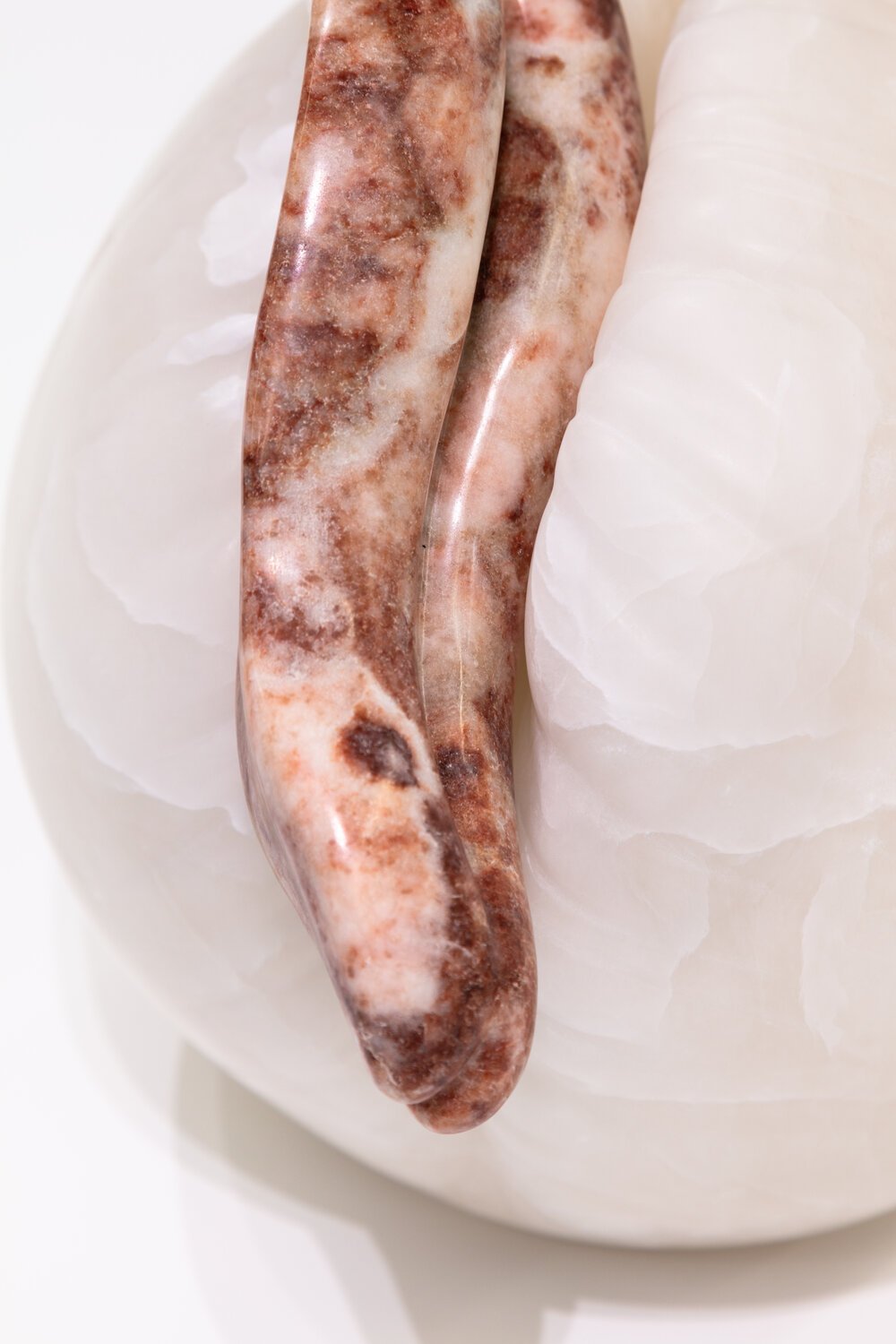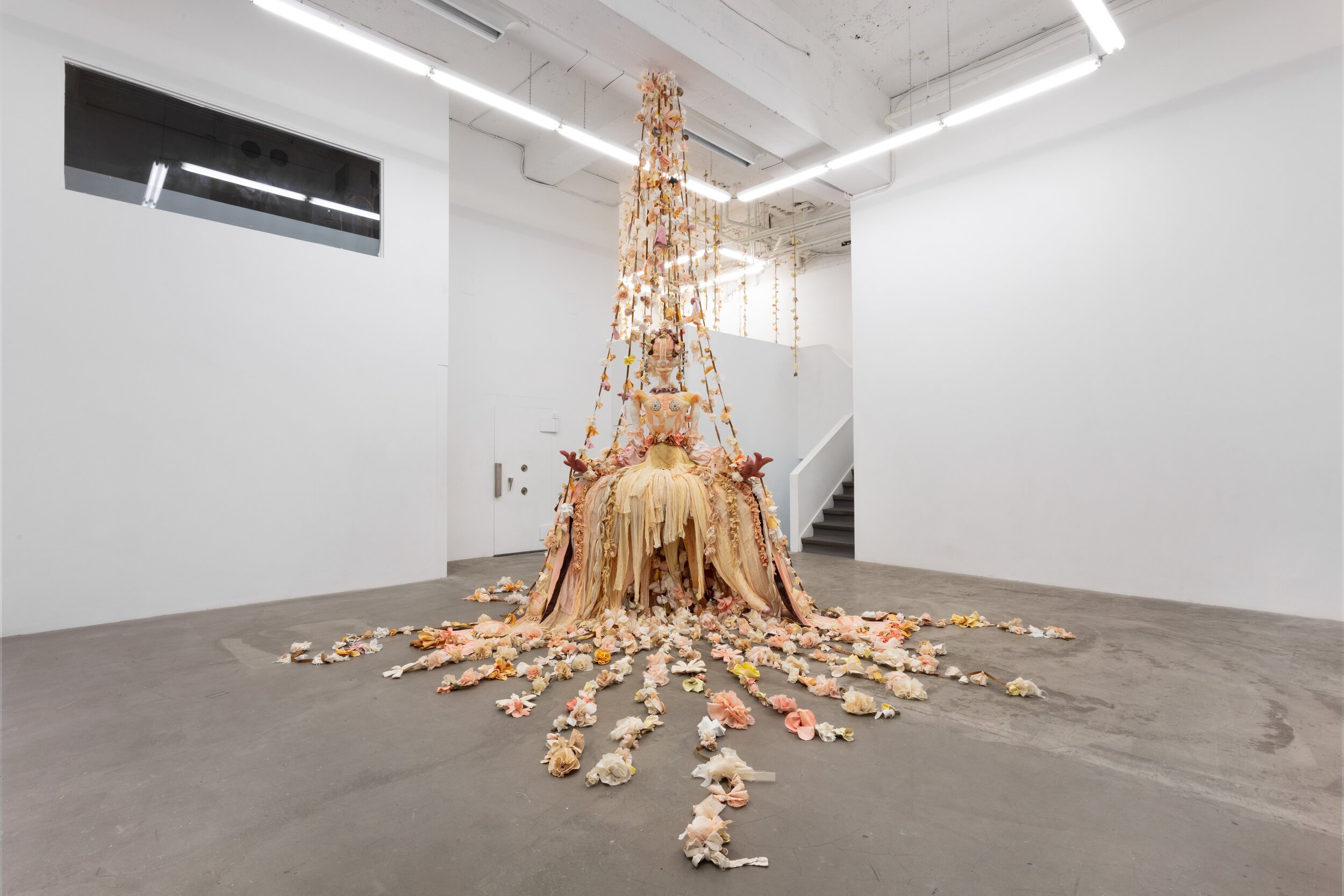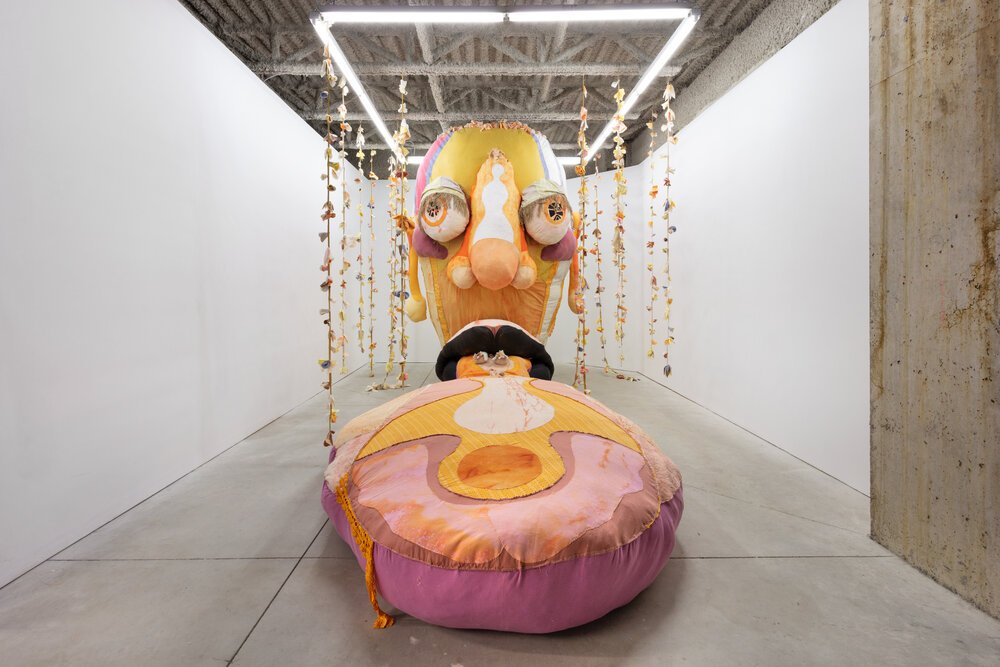The Ecologies of Kinship: A Double Exhibition Review
by :
Margaryta Golovchenko
Jennifer Rose Sciarrino: for Swan, 2020, installation view, Daniel Faria Gallery, Toronto.
Recently, the idea of motherhood has been challenged not only by redefinitions of the nuclear family but also by the parallel evolution of speculative fiction and of science. It is difficult to say which is catching up to which, only that the relationship between the fact and fantasy of motherhood has grown increasingly close with time. This relationship is illustrated by two recent exhibitions, bringing a light of hope as this unusually long and exhausting year draws to a close. Although seeming, at first glance, starkly different, Jennifer Rose Sciarrino’s for Swan at Daniel Faria Gallery and Tau Lewis’s Triumphant Alliance of the Ubiquitous Blossoms of Incarnate Souls at Cooper Cole ultimately feel like two sides of the same coin. The two exhibitions resonate through each other, presenting complementary approaches to contemplating how human existence might be connected to, rather than explained using, non-human existence. Although neither Sciarrino nor Lewis explicitly mentions motherhood, a sense of intimate kinship runs through both exhibitions. As well as imagining alternative beginnings and ends to existence, Sciarrino’s and Lewis’s work also draws on the fluid materiality of identity realized between these two poles, reminding the viewer that the self is always a communal creation. Rooted in these questions of production and reproduction, the two artists imagine alternative forms of parenthood that are focused on finding continuity within difference instead of being preoccupied with linear notions of biological and cultural inheritance.
for Swan is named after Swan Er Hong, an artist and former asteroid terrarium designer living on Mercury in Kim Stanley Robinson’s novel 2312. It has a distinct sparseness to it; Jennifer Sciarrino’s carved alabaster and cast glass sculptures feel like complex scientific and philosophical discourses on evolution and reproduction compressed into concentrated building blocks. The cavernous size of the gallery makes both the glass algae-like forms hanging on the wall and the array of stony, shell-like alabaster forms lying on unmortared brick pedestals feel surprisingly small, even delicate. This delicacy speaks not only to the material fragility of the works but also to the fragile accidents of coincidence that play a significant role in biological and astronomical evolution. After all, it is sheer luck that our planet has (or, now more accurately, had) the precise chemical combination to make a hospitable environment for humans.
“This delicacy speaks... to the fragile accidents of coincidence...”
Jennifer Rose Sciarrino, knot in the act, 2020. Carved alabaster, 7 x 16 x 9 1/2 inches. Courtesy of the artist and Daniel Faria Gallery, Toronto.
For those whose approach to looking at art is rooted in finding a neat correlation between a work’s title and its form, Sciarrino’s sculptures pose a challenge. The cast glass algae-like forms are each titled canary (all 2020), suggesting by means of metaphor, not likeness, the vulnerability of the endangered lichen species that served as the formal inspiration for the works. The title of a sculpture that consists (roughly speaking) of a globe-like base with a tongue-like form crawling through a crack down the middle, the splits (2020), is only one way of situating the work among, potentially, an infinite number of other identities. (For reference, the exhibition description tells us the splits depicts, “a frog embryo beginning to separate and an anther . . . com[ing] together in a strange embrace.”) knot in the act (2020) and a damp embrace (2020) recall biomorphic forms; respectively, a seal balancing a ball on its nose and a crab claw reminiscent of the giant crab monsters that populate the dystopian future of H.G. Wells’s The Time Machine. Overall, Sciarrino’s alabaster sculptures feel like variations on a Rorschach test, the results of which, as interpreted through the exigencies of psychoanalysis, are meant to reveal something of the test subject’s personality. It feels disingenuous to deny the sexual connotations — or, in the case of the splits, the inherently phallic forms — that arise when first looking at some of Sciarrino’s sculptures, yet this is a lens, only one of the many forms through which to view Sciarrino’s work rather than a truth embedded in its material form.
Jennifer Rose Sciarrino, the splits, 2020. Carved alabaster, 3 x 14 ½ x 4 ½ inches. Courtesy of the artist and Daniel Faria Gallery, Toronto.
This resistance to neat classification also plays into Sciarrino’s interest in exploring evolution and ecological histories from the perspective of speculative futures. From the unformed and natural-looking contours of the cast glass canary works to the more biomorphic but still multivalent carved alabaster sculptures, for Swan feels like a conversation between sexual and asexual forms of reproduction, with “asexual” also serving as a stand-in designation for those forms of reproduction that remain unknown to and difficult to imagine for us (as, for instance, the organism Tetrahymena thermophila, which “has not two but seven sexes and since the individual can mate with others of any gender except its own there are twenty-one possible sexual orientations.”1) In for Swan, the expansive white space of the gallery functions as a container for a social and scientific experiment, the brick pedestals petri dish altars holding their alabaster offerings, the shimmering glass algae casting a watchful eye from their places on the wall.
“...hidden behind corners yet clearly in possession of their own wisdom.”
A twenty-minute walk north in the brisk October air and I arrive at Cooper Cole, the site of Tau Lewis’s latest exhibition, Triumphant Alliance of the Ubiquitous Blossoms of Incarnate Souls. While Triumphant Alliance merges science fiction with queer feminist traditions rather than for Swan’s science and technology studies, both result in a contemplative atmosphere. The exhibition introduces the viewer to the realm of the T.A.U.B.I.S. (pronounced /taʊ /beez) in which familiar lines of division, such as gender, do not exist, and the first step to achieving a collective, or “uni-wide,” good is consent. The impressive lore that accompanies Triumphant Alliance is not necessary to appreciate Lewis’s work, but it certainly adds a dimension of social criticism, as well as a hopeful vision for an afterlife that makes even a sceptic like myself feel moved.
Made of reclaimed household textiles, each of the three figures created by Lewis — Symphony (2020) on the main floor, Delight (2020) in the basement of Cooper Cole’s main space, and Opus (The Ovule) (2020) in the gallery’s annex space — functions as a centre relative to its surroundings, as a focal point whose concentrated pastel colour palette grounds the otherwise industrially clean-looking space. It is difficult not to feel enveloped by a calm thoughtfulness upon entering the space and immediately coming face-to-face with Symphony, a large, mother-like figure that reminded me of Allyson Mitchell’s shag textile sculptures, like 2004’s Big Trubs. Symphony’s pointed, elf-like ears, bowed head and peaceful expression, and outstretched arms give the work an ethereal, motherly aspect without playing into any of her familiar tropes. The altar-like dress, with numerous flower-filled vines coming out of it, helps us locate the sculpture within Lewis’s narrative about the transmutation of souls into blossoms, each of which “embodies a soul who is alive and listening,” the artist tells us in an accompanying statement.
Jennifer Rose Sciarrino, the splits, 2020. Carved alabaster, 3 x 14 ½ x 4 ½ inches.Courtesy of the artist and Daniel Faria Gallery, Toronto.
“...regardless of what I choose to call this ethereal presence, I cannot shake the feeling that it is there. ”
Even within the exhibition, there is a non-hierarchical sense of community among the figures. Symphony may be the greeter yet Delight and Opus are equally important, separate from the central keeper of knowledge yet still close, hidden behind corners yet clearly in possession of their own wisdom. Opus in particular struck me as a more nurturing version of the disembodied head of Oz, the Great and Powerful. Opus also highlights Lewis’s interest in engaging with labour to address personal, collective and historical trauma.” The work hums with the concept of renewal; looking at the two magenta turtles repurposed to create part of the sculptures’ right ear strike me, I wonder where this piece of fabric originally came from, who owned it, and how it was used. The materiality of Lewis’s sculptures bolsters the exhibition’s exploration of continuity, which we can think of here as a circle of life or as a persistent memory indebted to communal knowledge. Standing next to Lewis’s sculptures, I can easily accept that I am yet another flower kept safe by something beyond my understanding, and regardless of what I choose to call this ethereal presence, I cannot shake the feeling that it is there.
Sciarrino and Lewis both reimagine what nature looks like as well as our place within it, reminding us that an ecosystem always includes the viewer who, by participating in the act of looking, writes themselves into the narrative. Yet this narrative is not linear, is not cause-and-effect, before-and-after. In his 2004 book No Future, American literary critic and professor of English Lee Edelman uses the term “reproductive futurism” to argue that our motivation to create a better future for our children is rooted in a belief that the future exists and is valid because we continue living through our children. Queerness exists in opposition to this constant future-looking, forward-moving momentum because queerness “is never a matter of being or becoming but, rather, of embodying the remainder of the Real internal to the Symbolic order.”2 Edelman’s argument positions queerness as rooted in and desiring the present (the Real), rather than anticipating an imagined potential future (the Symbolic), and emphasizes a desire for another individual in a relationship entirely outside of reproductive motivations. In for Swan and Triumphant Alliance, the artists offer a complete reimagining of the fundamental question of corporeal significance and individuality by doing away with all the boundaries that are at play in constructing a body: we are looking at possibilities, variations, a constant, cosmic game of rearranging building blocks that continues to evade our grasp no matter how close we think we are to solving it.
Tau Lewis, Symphony, 2020. Various recycled and hand-dyed fabrics, recycled leather, cotton batting, beads, acrylic paint, PVA glue, metal hoop skirt, pipe, seashells, wire, dimensions variable. Courtesy of the artist and Cooper Cole Gallery.
for Swan furthers Edelman’s idea by focusing on an overlooked part of the vast world that surrounds us, “The result of a relationship between two partners – a fungus and an alga . . . lichen demonstrate a reciprocity so deep that their very existence threatens our idea of modern individuality,” states the accompanying exhibition text, adding that the growth patterns of this relationship, “pose a challenge to notions of linear temporality.” for Swan speaks to the infinite potential that is contained within the unknown, which becomes all the more evident if one goes back to the theory of evolution and considers the fact that we all emerged from a single-cell organism and thus, technically, have a strange kinship with not only other humans but also other species.
The utopian vision and cosmic scale of Triumphant Alliance of the Ubiquitous Blossoms of Incarnate Souls should not be dismissed as an inspiring but impossible product of the imagination — such a dismissal would entail committing the same fallacious oversimplification as ignoring the sexual associations of Sciarrino’s sculptures. In fact, Triumphant Alliance offers a vital piece of dialogue in this thematic conversation with for Swan because it returns us to the creators’ unresolvable question. The greatest takeaway for me as I left Cooper Cole on one of October's last warm days was that creation is a communal act, and we are not alone in it. Whether it is our kin-in-existence, like fungus and algae, or potential kinships waiting to be discovered, like the watchful T.A.U.B.I.S. consciousness kept safe by the Ovule, Opus, there are as many ways of defining “creation” as there are engaging with it. One thing, however, is constant: we always embark on the process collectively.
Tau Lewis, Opus (The Ovule), 2020. Various recycled and hand-dyed fabrics, recycled leather, acrylic paint, recycled polyester batting, jute, metal, PVA glue, secret objects, safety pins, metal hooks, wire, dimensions variable. Courtesy of the artist and Cooper Cole Gallery.







